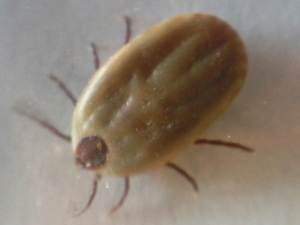Approximately 30 species of ticks are found throughout Colorado. Most common at higher elevations, ticks are blood-feeding parasites. Hard-shelled ticks are the most predominant and include some of the most common species of ticks in the state such as the RockyMountain wood tick, American dog tick and the brown dog tick. Hard-shelled ticks have a characteristic plate on the back just behind their head. A vast majority of human encounters involve the RockyMountain wood tick or the closely related American dog tick. Life stages of these ticks include egg, larva (also known as a seed tick), nymph and adult. Both of these ticks are typical three host ticks meaning that in order to complete their life cycle, they require three separate hosts. Hard-shelled ticks, during each stage of development, attach themselves to a host, feed for several days before becoming extremely engorged and dropping off of their host.
Females lay eggs on the ground. The emerging larvae typically seek out a small animal such as a rodent for their first meal. After dropping back to the ground, the larvae will molt becoming a nymph. They too seek out small animals on which they can feed before dropping to the ground for the second molt into an adult. The adult stage of the RockyMountain wood ticks and American dog ticks are the stage that feed on a larger animal such as a deer or dog. Occasionally, the adult stage will feed on a human host although this is not a preferred host for either of these ticks. After the final feeding, the tick drops off of the host to find a mate and the female lays eggs on the ground restarting the life cycle process. Ticks are attracted to hosts by carbon dioxide, to which they are highly sensitive and is exhaled by animals as the pass. Ticks often position themselves at the top of vegetations such as long grasses in order to allow them to quickly latch onto a potential host as it passes. RockyMountain wood ticks, American dog ticks and many others have peak activity from as early as March until mid to late July depending on temperatures. Tick life cycles can take a matter of only a few months or up to several years depending on their ability to successfully find hosts during each stage of development. They are extremely resistant to starvation and can actually survive without a blood meal for several years. Avoiding areas where ticks are likely to occur and breed, wearing tick repellent and protective clothing as well as conducting tick checks when you have been in areas considered as tick habitat are all ways to assist in avoiding tick activity.
One multiple host tick that has a very different life history is the brown dog tick. Unlike its relatives, this tick is capable of breeding continuously indoors. The tick will often feed on a single dog, or another available household host, during each of the three stages of development. The brown dog tick is a subtropical species and cannot survive outdoors year-round in Colorado. Infestations commonly occur in areas frequented by the dog including kennels, beds and furniture where the dog commonly sleeps. After an adult consumes their blood meal, they commonly crawl up the walls and lay eggs in cracks and corners of the room. Control for brown dog ticks must include treatment of the dog as well as their environment in order to eliminate the infestation. It is recommended to consult with your dog’s veterinarian to determine the best solution for treatment of your pet. The assistance of a pest control professional may be helpful in treatment of the home. In addition, it is important to thoroughly vacuum all areas of the home including cracks and crevices and then promptly empty the vacuum in order to prevent ticks from escaping. Due to their sensitivity to cold temperatures, some items may be frozen or exposed to cold temperatures in order to eliminate activity on those items.
Ticks are known for carrying multiple diseases, therefore if you or your pet has knowingly been exposed to ticks, contacting your doctor or veterinarian for information on any actions necessary is recommended. Thankfully, Colorado is not known habitat for ticks that carry Lyme disease, which is a problem in the eastern United States. Colorado tick fever is the most common tick-transmitted disease in our region and is transmitted by both the RockyMountain wood tick and the American dog tick. Although illnesses related to blood loss from ticks can occur, they are rare and usually only in wildlife and livestock.
